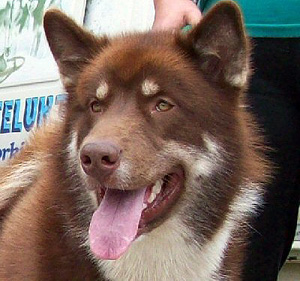
Canadian Eskimo Dog
Group: Working Dog Group
Height: 27½ inches (70 cm)
Weight: 66 to 88 lbs. (30 to 39 kg)
Other Names: Qimmiq

Shepherdsway River of Gold – “Hawk”
Photo courtesy of FENSKIMOS
CLICK HERE to View Breeder Listings
Breed Profile
Originating from the Canadian Arctic, the Canadian Eskimo Dog is called “Qimmiq” by the Inuit and is the oldest indigenous breed still in existence in North America. The breed was popular with Arctic explorers and had a reputation as the sled dog that could pull the heaviest loads, over the greatest distances, on the least amount of food. In the 1950’s it was estimated that 20,000 Canadian Eskimo Dogs lived in Canada’s North. However, when snowmobiles gained favour, the number of Eskimo Dogs declined almost to the point of extinction. In the 1970s, a project, funded by the CKC, the Canada Council and private individuals saved the breed. Still, today it is estimated that there are less than 300 purebred CKC registered Canadian Eskimo Dogs in the world making the breed one of the rarest.
The Canadian Eskimo Dog is a gentle and affectionate companion. The breed does not adapt well to temperate climates. He is primarily a working dog, born to pull and, therefore, needs plenty of outdoor exercise preferably in sub-freezing temperatures.
Health Issues
If you are considering the adoption of a Canadian Eskimo Dog puppy, or any breed, it is very important to be selective in choosing a responsible and reputable breeder. Ensure that the prospective puppy’s parents have all health clearances. Breeding of any dog should not be done until after they have been proven to be free of evidence of significant hereditary diseases. (For more information on selecting a breeder, see the articles on the General Information page.)
Additional Health Resources:
- Health and Nutrition — Growing section of the Canada’s Guide to Dogs website which includes information on several health and nutrition related issues.
- Canine Health Information Center (CHIC) — Providing a source of health information for owners, breeders, and scientists that will assist in breeding healthy dogs. CHIC is a centralized canine health database jointly sponsored by the AKC/Canine Health Foundation (AKC/CHF) and the Orthopedic Foundation for Animals (OFA).
- AKC Canine Health Foundation — Working towards developing scientific advances in canine health.
- OFA – Companion Animal Eye Registry (CAER)
- Orthopedic Foundation for Animals (OFA)
- Ontario Veterinary College (OVC)
- University of Pennsylvania Hip Improvement Program (PennHip)
- HealthGene — HealthGene Corporation is the leading provider of veterinary DNA diagnostic services in Canada.
- Labgenvet — Laboratory of Veterinary Genetics is a Canadian diagnostic laboratory that offers a comprehensive service of DNA tests for veterinary genetic diseases.
Grooming Information
- Grooming — This section of the Canada’s Guide to Dogs website includes tips, articles and information covering all aspects of dog grooming along with a listing of Groomers from across Canada.
Training Resources
- Training — For training information, see this growing section of the Canada’s Guide to Dogs website for tips, articles, as well as listings of training centres across Canada.
Additional Information
- Clubs, Sports & Activities — For information on the many sports and activities you can get involved in with your dog.
- Working Dogs — The Working Dogs section of the Canada’s Guide to Dogs website provides information and listings of organizations that are involved in various dog jobs, such as Guide Dogs, Therapy Dogs, Police Dogs, Protection Dogs, and much more.
*NOTE 2: The Fédération Cynologique International (FCI) is the World Canine Organization, which includes 91 members and contract partners (one member per country) that each issue their own pedigrees and train their own judges. The FCI recognizes 344 breeds, with each being the “property” of a specific country. The “owner” countries write the standards of these breeds in co-operation with the Standards and Scientific Commissions of the FCI, and the translation and updating are carried out by the FCI. The FCI is not a breed registry nor does it issue pedigrees.
Breed Listing
Quick Links
Get In Touch
- Email: canadasguidetodogs@gmail.com
- Email: info@canadasguidetodogs.com
- Visit us on Facebook: www.facebook.com/CanadasGuideToDogs
— CanadasGuideToDogs.com is an Amazon Associate as well as a participant in various affiliate programs, as such fees are earned from qualifying purchases.
